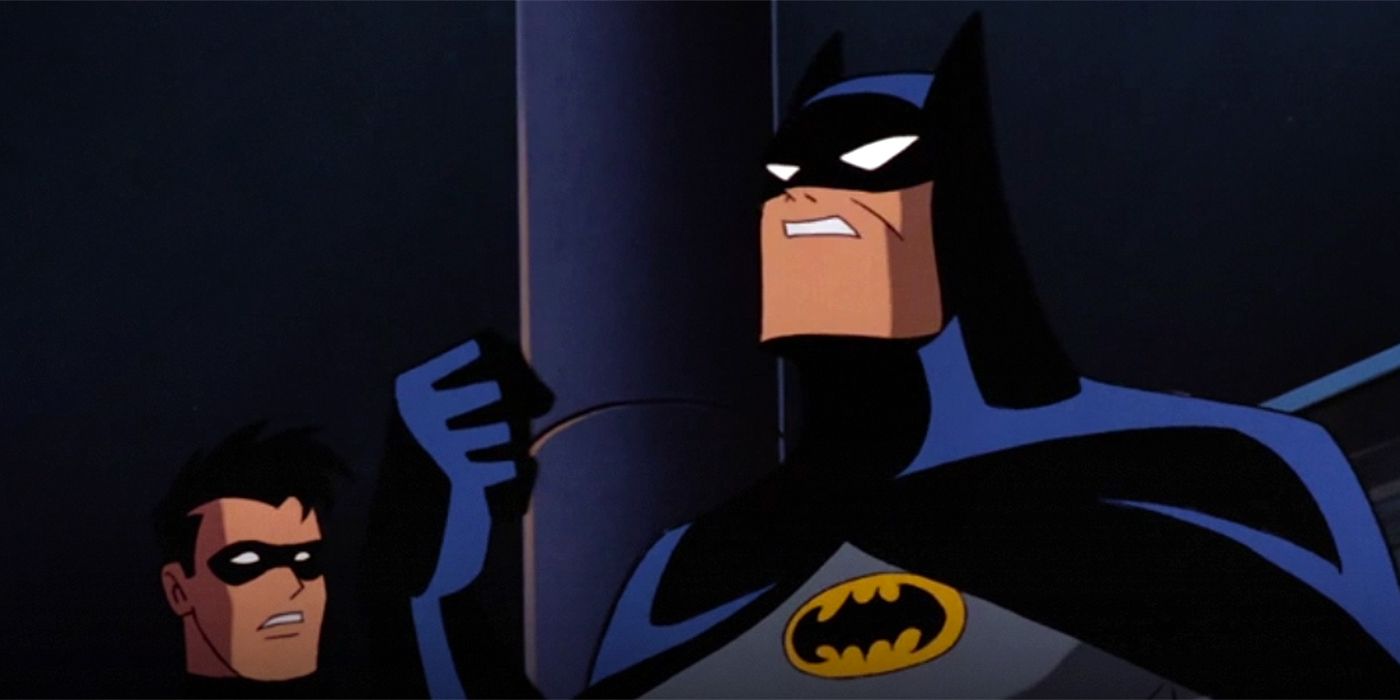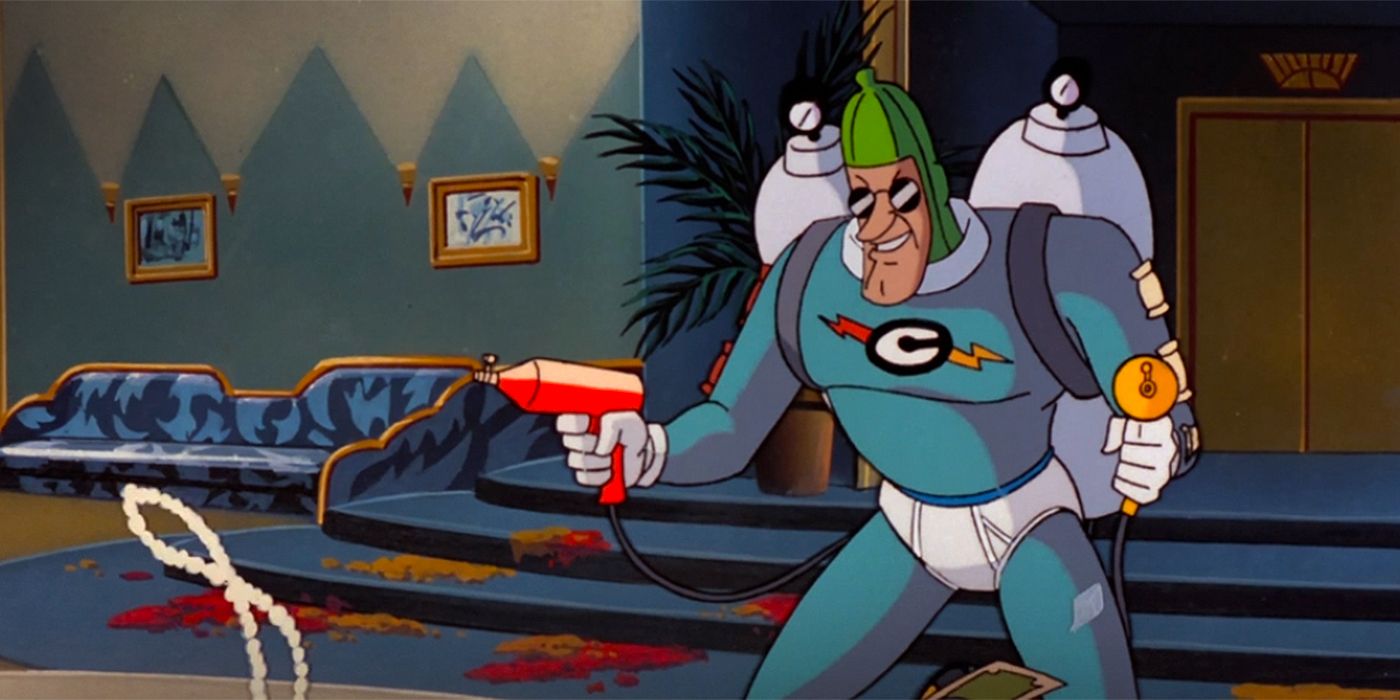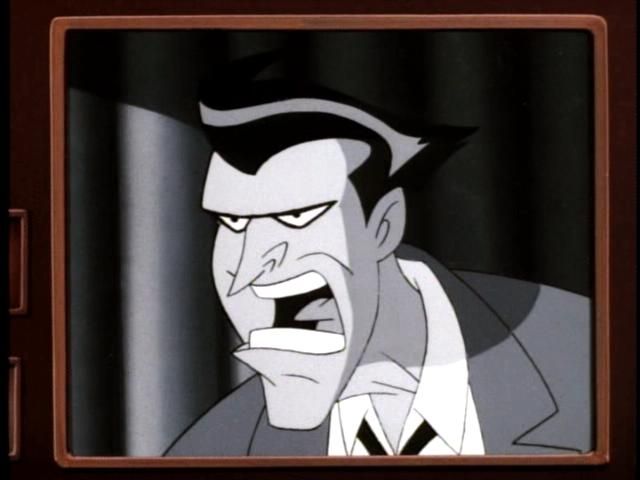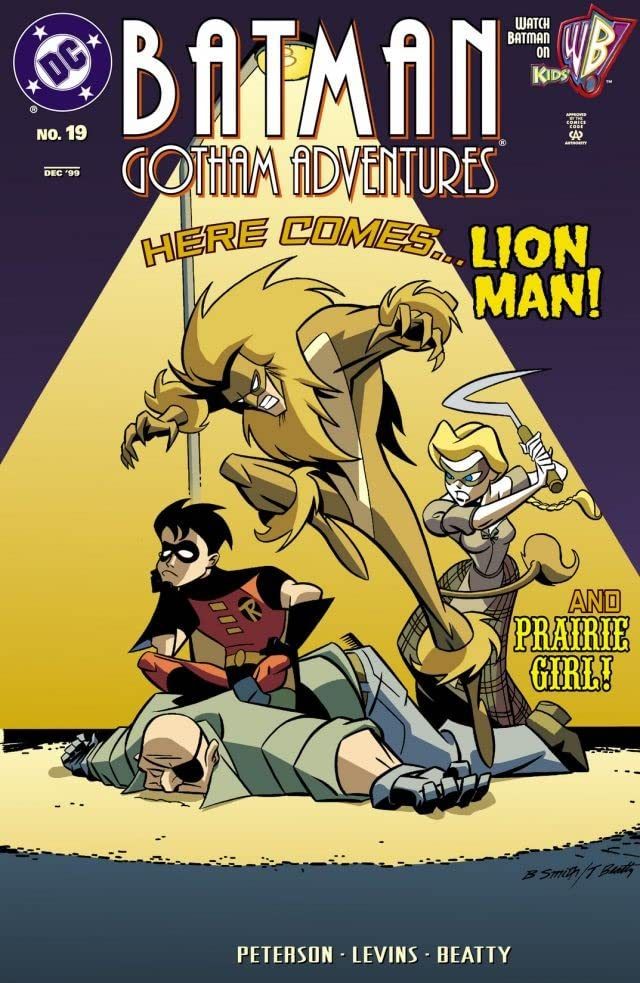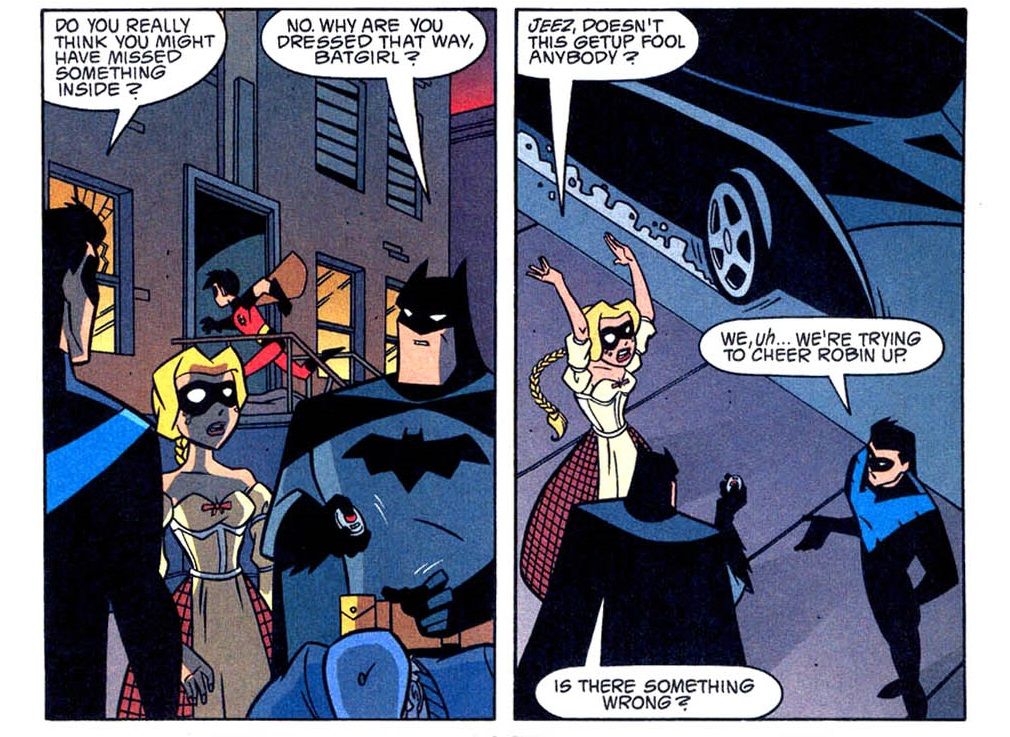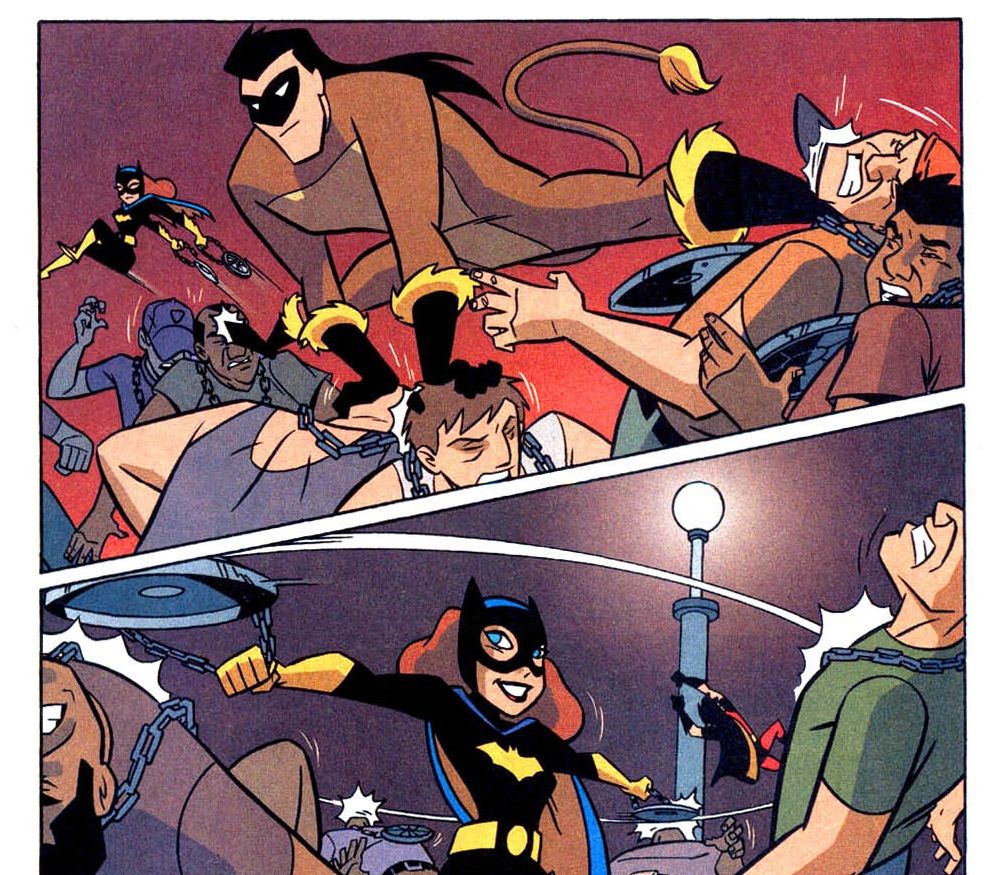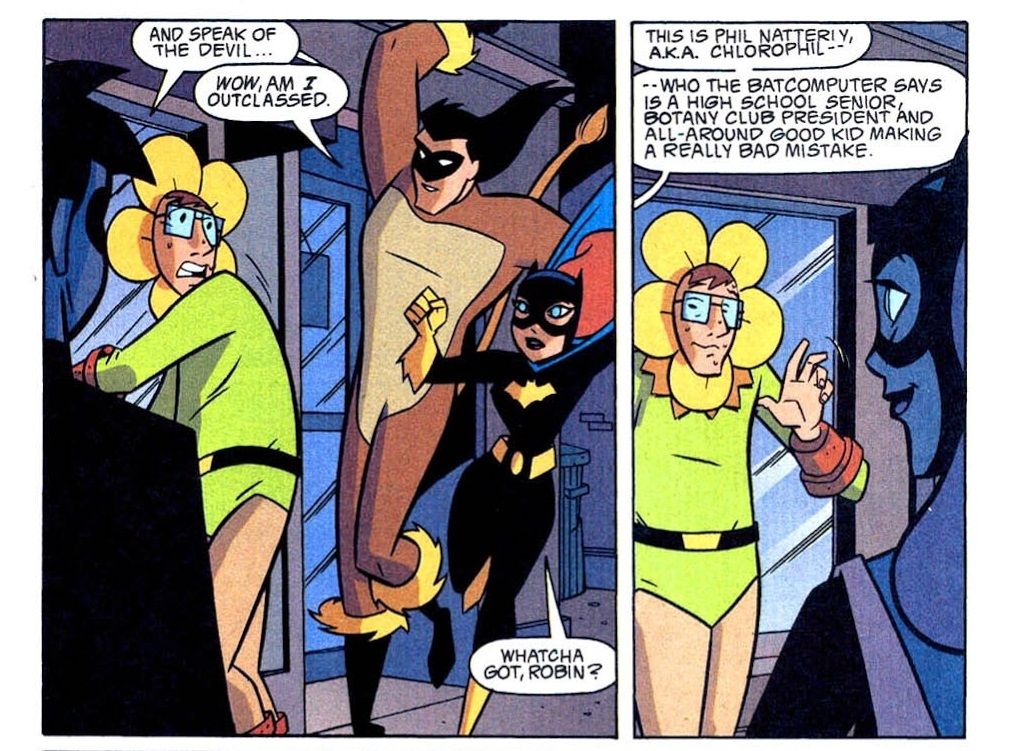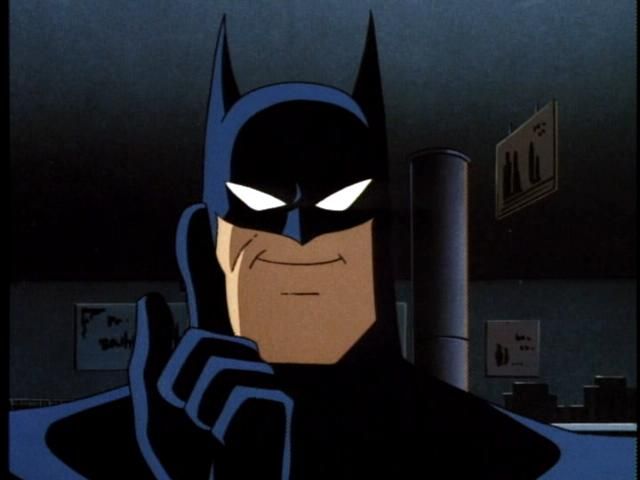Welcome to Adventure(s) Time's 145th installment, a look at animated heroes of the past. This week, two tales of the animated Batman that bring us laughably awful villains -- and established characters in disguise. And if you have any suggestions for the future, let me hear them. Just contact me on Twitter.
Premiering on Nov. 5, 1994, "Make 'Em Laugh" is an episode of Batman: The Animated Series that aired during its stint as the rebranded The Adventures of Batman & Robin. The story is from two of the show's strongest writers, Paul Dini and Randy Rogel, and directed by Boyd Kirkland, another of the show's top talents. It's a difficult episode to forget -- likely the most absurd starting point of an episode, yet admirable for its willingness to run with its premise.
The setup has three famous comedians suddenly committing ludicrous crimes in Gotham. The first to appear is the Condiment King, who holds up an upscale restaurant, while literally wearing his underwear on the outside.
Then, the Pack Rat debuts, robbing a luxury department store of such items such as pocket lint instead of jewelry. As Batman and Robin investigate why these comedians have suddenly turned to crime, comedian Lisa Lorraine (clearly based on Roseanne Barr) is abducted from her apartment by a man who sounds an awful lot like famed actor Mark Hamill.
Batman discovers a microchip affixed to the neck of one comedian, which he recognizes as the Mad Hatter's form of mind control. The Dynamic Duo heads to Arkham Asylum to visit Mad Hatter, but discover him immobile, a victim of his own technology. Someone with access to the Mad Hatter has stolen his mind control tech -- but who could it be?
After learning of Lisa Lorraine's abduction, the Dynamic Duo realizes these three comedians were judges at Gotham's annual "Laugh-Off" comedy competition. (This oddly predicts the NBC reality show Last Comic Standing, which featured a panel of three established comedians judging aspiring stand-ups.) Alfred presents footage of the event, cued up to something interesting.
A late entry named Smilin' Shecky Rimshot rushed the stage, but was prevented from performing by the judges. Enraged, Shecky declared in a familiar voice that he was Gotham's greatest comedian, and he would have his revenge. The heroes quickly discern Shecky was the Joker in disguise.
That night, at this year's comedy competition, Joker again performs as Smilin' Shecky, before revealing himself and terrorizing the crowd. Batman and Robin arrive, and while the Dark Knight dashes off for a confrontation with Joker, the Boy Wonder is stuck dealing with Lisa Lorraine's new supervillain persona, "Mighty Mom." She turns out to be a formidable opponent for Robin (who takes his licks in these episodes; was this the producers' way of venting frustration over the network edict for him to appear in each episode?).
During his fight with Batman, Joker falls off of a balloon, resulting in his pants falling down when the Caped Crusader catches him with a grapple gun. As Joker is taken away by the police, the crowd roars with delight. Joker isn't happy, of course, because they're laughing at him, not with him.
The temptation to create absurd villains is difficult to resist, and it's not that surprising that, five years later, a similar premise would appear in the show's tie-in comic, Batman: Gotham Adventures. "A Little Thing!" is the title's 19th issue, from writer Scott Peterson and penciler Tim Levins.
In "A Little Thing!," the new Robin, Tim Drake, is disillusioned by the number of unstable, armed violent men the heroes have been facing lately. Nightwing (formerly the Dick Grayson Robin of Batman: The Animated Series, of course) and Batgirl listen as he longs for more creative villains. That could be read as a meta-commentary on the darkening tone of the era's mainstream Batman titles. Colorful, outrageous villains had fallen out of style, replaced by serial killers, political corruption, and organized crime.
Soon, a new villain called Prairie Girl debuts. Robin immediately recognizes this as Batgirl in disguise; so does a bewildered Batman, who calls the team for assistance.
On another night, Robin and Batgirl are on patrol when another new villain, Lion Man, makes his big public splash. Robin isn't fooled: This is Nightwing in disguise. Robin suggests Nightwing should've teamed with Metallo and Scarecrow to complete the Wizard of Oz homage. The heroes then have to respond quickly to a police alert -- a hubcap-themed group of criminals is breaking into an auto supply store. Nightwing doesn't have a chance to change out of his lion outfit.
While traveling home alone, a despondent Robin encounters someone dressed as a sunflower, Chlorophil, unsuccessfully trying to rob a flower shop. He's bungling the job, and won't stop calling himself an imbecile. Robin shows the teenager sympathy, and decides to let him go.
Later in the Batcave, Robin's mood is lifted, following his encounter with a genuinely goofy, harmless villain. He also thanks Batgirl and Nightwing for trying to cheer him up. When Robin leaves the cave, Batman thanks Alfred for his "assistance," shocking Nightwing and Batgirl. Yes, trained actor (and that's established canon) Alfred was Chlorophil all along, pulling off what the younger heroes simply couldn't.
'Make 'Em Laugh' Raises Some Batman (& Joker) Continuity Questions
The implication seems to be that Joker's appearance as Smilin' Shecky Rimshot predates him becoming a sadistic villain, which makes the timeline of the show quite odd. For one thing, we know the Joker was stalking accountant Charlie Collins for years in one of the earliest episodes, "Joker's Favor." (Although it's maybe possible Joker was inspired to participate in this comedy contest this in-between crime sprees and Arkham stints.) Another oddity has Robin holding today's newspaper, announcing "Rally To Be Held For Gordon," a headline also used years earlier in the episode "Shadow of the Bat." Additionally, Lisa is watching a clip from a far more recent episode, "Riddler's Reform," when Joker arrives to kidnap her. When does this episode take place?!
It's also possible this story was inspired by Alan Moore and Brian Bolland's Batman: The Killing Joke, which gave Joker a potential origin that had him as a frustrated stand-up comedian.
Surprisingly, Condiment King has risen about his status as a toss-away joke. He made his debut in the official comics continuity in 2002's Birds of Prey #37, from creators Chuck Dixon and Marcos Martin, later appearing in Batgirl: Year One and Robin. The comics Condiment King is the deranged Mitchell Mayo, and would even appear in the video game LEGO Batman 3, and the film The LEGO Batman Movie.
'Make 'Em Laugh' Includes Classic Comedy & Comic Book Nods
Joker victims Buddy Standler and Harry Loomis were likely named in honor of comedians Buddy Hackett and Jerry Lewis. And the premise of the episode has similarities with Martin Scorsese's 1983 film The King of Comedy, which has an aspiring, delusional stand-up Rupert Pupkin kidnap his idol, portrayed by Jerry Lewis. 2019's Joker film directly used King of Comedy as inspiration, and featured Rupert Pupkin himself, Robert De Niro, in a prominent role.
Batman Fans Like 'Make 'Em Laugh,' Despite the Camp Elements
"Make 'Em Laugh" would seem to be an easy target for fan ire. The continuity is potentially an issue, the premise hinges on Batman facing intentionally lame villains, and the normally dark tone of the series is absent. The diehards typically hate stories like this. But "Make 'Em Laugh" seems to be held in pretty high regard. It works as a knowing nod toward the campy 1960s Batman television show, but the humor works within the context of the series. Batman himself isn't the butt of the joke, and the world of Gotham still feels true to what we've seen in previous episodes. Everyone knows these villains are ridiculous, and that's vital to the episode's premise.
The story's also true to this canon's interpretation of the manic Joker -- his motivations might seem capricious, but one consistent trait is his ego. He lashes out whenever he feels he hasn't been paid his proper respect, like when a casino owner appropriates his image, and hates the thought of ever being the butt of the joke.
"A Little Thing!" also has an element of meta-messaging and plays on the humor of really terrible villains, while offering the audience something the canon Batman titles weren't providing at the time. The mainstream books were in the process of alienating Batman from his allies, presenting him as a driven warrior unable to relate to the surrogate family he'd created around him.
Peterson and Levins present a rather functional Bat-family, people who care about each other and seem to enjoy their place in the absurd world of Gotham. The ending is also a twist on a twist, yet it plays fair with the reader. It's another example of creators having fun within the show's world without truly breaking any of the rules. Apparently, none of the ridiculous foes were able to capture the public's attention like Condiment King, though.

